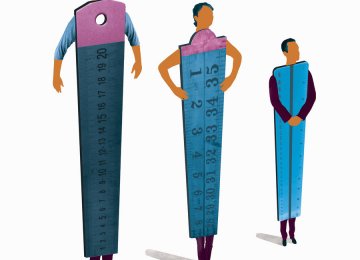Big or tall women are nearly three times as likely to develop the dangerous irregular heart rhythm known as atrial fibrillation than smaller women, a preliminary study says.
The larger a woman’s body size as a young adult, the more likely she is to develop the heart disorder later in life, according to the researchers.
“There was a stepwise elevation in risk with increasing body size,” said study author Dr. Annika Rosengren, CBS News reported.
“The group with the highest body surface area had nearly three times the risk as those with the lowest body surface area,” added Rosengren, a professor of internal medicine at the University of Gothenburg in Sweden.
Atrial fibrillation is an irregular heartbeat that develops in the atria -- the two upper chambers of the heart. The quivering heartbeat increases risk of stroke, heart failure and other heart rhythm problems.
It’s the most common heart rhythm disorder, and everyone has a 1 in 5 chance of developing atrial fibrillation during their lifetime, researchers said. The problem occurs most often in people older than 60.
“The implications may be substantial, because the world population is growing taller as well as heavier,” Rosengren said. “We might be looking at substantially more AF in the future.”
A previous study found that husky or tall young men were more likely to develop atrial fibrillation as they aged, particularly if they gained weight.
Researchers who reviewed data on 1.5 million Swedish women using a national birth registry tracked the women for 16 years on average. During that time, more than 7,000 women were hospitalized with atrial fibrillation, at an average age of 49.
Increased Risk
Compared to the smallest women, the largest women had a 2.6-times increased risk of atrial fibrillation, after adjusting for other risk factors, researchers found. The risk increased with women’s initial body size.
Rosengren said having a big body means having a big heart with larger-than-usual atria, which raises the risk.
Dr. Allan Stewart, director of aortic surgery for Mount Sinai Health System in New York City, said heart muscle tissue serves a dual function. Each cell contributes to the regular heart muscle contractions that pump blood through the body. But the cells also pass along an electrical impulse that controls the rhythm of the heartbeat.
Big atria challenge this heart function. “You have the same number of cells, but when they’re stretched and they increase in size, it interrupts the electrical pathway of the heart. You go from a normal rhythm to atrial fibrillation.”
Just being big in and of itself likely adds to the problem, said Stewart, who wasn’t involved in the study.
The findings were presented at a meeting of the European Society of Cardiology in Malaga, Spain. Studies presented at meetings are usually considered preliminary until published in a peer-reviewed medical journal.






Add new comment
Read our comment policy before posting your viewpoints